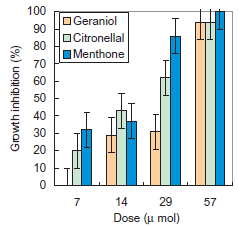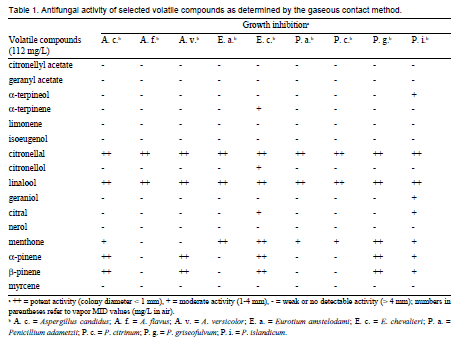Growth-inhibitory activity against maize weevil and the antifungal activities of volatile compounds from citronella grass
Description
Numerous aromatic plants are endemic to Southeast Asia. In addition to their use in food and cosmetics, they have long been employed as mosquito repellants and antifungal household fumigants. This suggests that aromatic plants and their volatile components might be effective against certain postharvest pests. In fact, terpenes, which commonly occur in these aromatic plants, exhibit various biological effects on harmful living organisms. Natural products are generally regarded as safe and more environment-friendly than synthetic chemicals, and there is a little chance of the occurrence of resistant pests. Thus, by applying locally obtained aromatic plants, we aim to develop an alternative method for eliminating postharvest pests. First, we determined the growth-inhibiting effects of four selected aromatic plants, citronella grass (Cymbopogon nardus), lemon grass (Cymbopogon citratus), pomelo (Citrus grandis) peel, and fingerroot (Boesenbergia pandurata) rhizomes, against maize weevil (Sitophilus zeamis) and nine fungal strains that are sometimes detected in Thai rice. Of the four plants, citronella grass showed the highest effects against both weevils and fungi. In particular, the citronella oil completely inhibited all nine tested fungal strains at low doses. Citronella grass (Cymbopogon nardus) is a perennial grass growing mainly in South and Southeast Asia. The essential oil extracted from it, citronella oil, has a characteristic rosy and herbaceous-citrus aroma, and is used for several industrial purposes. Next, the active principles in the citronella oil were identified. The composition of steam-distilled citronella oil was analyzed by capillary gas chromatography and gas chromatography/ mass spectrometry. The major volatile components in the sample, obtained in Bangkok, Thailand, were geraniol (35.7% of total volatiles), trans-citral (22.7%), cis-citral (14.2%), geranyl acetate (9.7%), citronellal (5.8%), and citronellol (4.6%). The growth inhibitory activity of major components of citronella oil and structurally related compounds against weevils was determined using the following method. Two hundred and fifty randomly selected adult maize weevils were reared on polished rice (410 g) at 30°C and R.H. for 7 days. Ten-gram samples of this rice, on which these weevils had laid eggs, were then transferred into 0.57-liter glass containers and incubated for 8 weeks sealed shut. Each compound was directly dropped inside the container to give a concentration of 15.4 ppm at the beginning of the experiment. The inhibitory activity was evaluated by the number of emerged adult descendants. Nine out of the 19 compounds examined suppressed more than 50% of development of adult weevils from eggs. Notably, three monoterpenes (menthone, trans-geraniol, and citronellal) showed a strong inhibitory effect (Fig. 1). The antifungal activity of the components of citronella oil and related compounds was determined by the vapor-agar contact method as follows. Fungal spores (1.5 x 103) were incubated on potato-dextrose agar plate in a sealed chamber (capacity 300 mL) with volatiles. Antifungal activity was evaluated by measuring the diameter of the formed colonies. Two monoterpenes, citronellal and linalool, exhibited complete inhibition of the growth of all nine tested fungal strains at a dose of 112 ppm (Table 1). The terpenes that showed growth-inhibitory effects against weevil and antifungal activity have specific flavors, so there were concerns that the absorption of these substances into the rice grains would affect the palatability of the stored rice. Absorption tests and sensory evaluation tests showed that a large portion of citronellal adsorbed onto surfaces of rice grains could be removed by milling or simply leaving in the open air. Residual citronellal would decrease to below detectable levels during transportation and cooking. These results suggested that some aromatic plants and volatile components of aromatic plants, e.g., menthone, trans-geraniol, citronellal, and linalool, have potential as effective postharvest chemicals to protect stored food.
Figure, table
-
Fig. 1. Growth-inhibitory activity of geraniol, citronellal, and menthone against maize weevil. -
- Affiliation
-
Japan International Research Center for Agricultural Sciences Food Science and Technology Division
-
Institute of Food Research and Product Development, Kasetsart University, Thailand
Faculty of Agriculture, Khon Kaen University
- Classification
-
Technical A
- Term of research
-
FY2004(FY2000~2004)
- Responsible researcher
-
NAKAHARA Kazuhiko ( Food Science and Technology Division )
ALZOREKY Najeeb S. ( Sanaa University )
Trakoontivakorn Gassinee ( Kasetsart University )
Hanboonsong Y. ( Faculty of Agriculture, Khon Kaen University )
- ほか
- Publication, etc.
-
Nakahara, K., Alzoreky, N. S., Yoshihashi, T., Nguyen, T. T. H., and Trakoontivakorn, G.(2003): Chemical Composition and Antifungal Activity of Essential Oil from Cymbopogon nardus(Citronella Grass). JARQ, 37 (4), 249 - 252.
NAKAHARA, K. et al. (2002) Abstracts of the Annual Meeting of the Japan Society for Bioscience, Biotechnology, and Agrochemistry 2003. 3E03p22
- Japanese PDF
-
2004_14_A3_ja.pdf726.78 KB


